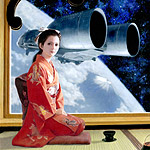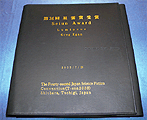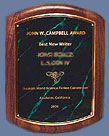

About Nippon 2007
About WorldCons
Agents
Art Show
Awards
Blogs/Galleries
Checklist
Child Care
Committee
Contact Us
Con Suite
Contests
Dealers Room
Donbura-con
Exhibits
Facilities / Maps
F A Q
Fanspeak
Filking (Music!)
Guests of Honor
Handicapped Services
Hotels
Hotel Alternatives
Hugo Awards
Hugo Winners
Hugo Nominees
Rocket Archive
Language/Food/Culture
Links
LiveJournal
Main Events:
Masquerade
Members
Mmbrshp Transfer
Newsletters (At Con)
Parties
Photos
Program - Western
Program Grid
Program Participants
Program - Japanese
Publications
Registration
Seals/Stickers
Seiun Awards
Site Map
Site Selection 2009
Speculative Japan
Tour with Fans
Ghibli Tour
Travel
Travel Links
Volunteers
World S F Society
Nippon Bid Site
Nippon2007.org
Archon 31 (NASFiC)
2008 Denvention 3
2009 Anticipation
![]()
![]()
Awards
Hugo Award
|
Hugo Seiun Campbell Komatsu Chesley Golden Duck BSFA Skylark Prometheus Japanese |
This year's Hugo Award Winners.
The Seiun Award
The Japanese word "Seiun" means "nebula," however this award is not at all related to the Science Fiction Writers of America (SFWA) Nebula Award. "Seiun" was the name of the first professional SF magazine in Japan, published in 1954 and discontinued after only one issue because of extremely poor sales. This award was named after that short-lived forerunner commemorating the dawn of Japanese SF.
 Each year the Nationalcon attendees' votes are gathered, checked, and tallied by The Federation of SF Fangroups of Japan, founded in 1965. The Federation of SF Fangroups of Japan presents certificates of merit and the convention committee provides trophies for the winners. Each committee designs the shape and material of the trophies; which vary widely from year to year.
Each year the Nationalcon attendees' votes are gathered, checked, and tallied by The Federation of SF Fangroups of Japan, founded in 1965. The Federation of SF Fangroups of Japan presents certificates of merit and the convention committee provides trophies for the winners. Each committee designs the shape and material of the trophies; which vary widely from year to year.
The first Seiun Award was presented at Tokon 5, the ninth Japanese National Convention, held in 1970.
Originally there were five categories: Japanese Novel, Japanese Short Story, Translated Novel, Translated Short Story and Media Work, each awarded to the best item in that category published or released in the prior year. Categories for Artist and Comics were added in 1979; Nonfiction in 1985; and "Nonsectional" or Free Section in 2002. This last category is a catch-all covering anything that the SF community found fascinating.
For nearly ten years no announcement was made about the award overseas, and consequently the winners for the Translation categories were seldom aware of their honors. This situation changed during Noreascon Two in 1980, when a private presentation was made in the Con Suite, with other attendees present. The winning works in 1979 were Ringworld and Inconstant Moon, both by Larry Niven. The certificates and trophies were presented to Mr Niven by Takumi Shibano (the translator of both works using the pseudonym Rei Kozumi).
During the next several Worldcons, the Seiun Award presentations were made by Takumi Shibano. Later, when Mr Shibano was unable to attend Worldcons or to provide an introduction for other international fans attending Worldcons: Katsumi Shindo, Katsumi Kushimoto, Takayuki Tatsumi, Yoshio Kobayashi, Masamichi Osako and Kiyoshi Imaoka, to name several, presented the Seiun Awards. Shibano's role was succeeded by Masamichi Osako in 1991, then, in 1997. (by Takumi SHIBANO)
This year's Seiun Award Winners.
John W Campbell Best New Writer Award
 The John W Campbell Best New Writer Award is given to the best new science fiction or fantasy writer whose first work of science fiction or fantasy was published in a professional publication in the previous two years. For the 2007 award, which is presented at the World Science Fiction Convention (WorldCon), the qualifying work must have been published in 2005 or 2006.
The John W Campbell Best New Writer Award is given to the best new science fiction or fantasy writer whose first work of science fiction or fantasy was published in a professional publication in the previous two years. For the 2007 award, which is presented at the World Science Fiction Convention (WorldCon), the qualifying work must have been published in 2005 or 2006.
The Campbell Award is administered by the Worldcon, but it is not a Hugo, and the rules for awarding the Campbell are determined by the award sponsor, Dell Magazine.
This year's Campbell Award Winner.
The Komatsu Sakyo Award
The "Nippon SF Shinjin-sho" (or the "Sakyo Komatsu Award") was established in 1999, to spotlight outstanding new talent in the Japanese science fiction world. It was named after Sakyo Komatsu, a leading writer of Japanese SF.The award was established to expand the possibilities of science fiction literature, but it is not limited to SF. Fantasy and horror are included in the broad works of entertainment. Also, the award differs from the usual literary award in that the final choice rests with just one person - Sakyo Komatsu. The award is under the auspices of the Kadokawa Haruki Corporation. The sponsors are the Japan Aerospace Exploration Agency, The Japan Agency for Marine-Earth Science and Technology, The Japan Atomic Energy Agency, and RIKEN.
Below is the dedication that Sakyo Komatsu wrote when the Komatsu Sakyo Award was established.
-
On the occasion of the establishment of the Komatsu Sakyo Award
Once, SF was an infinitely expanding circle of daydreams, a story of the future and of the human race.
But science showed us progress beyond the novels, and it wasn't so strange anymore when reality went beyond fiction.
But, having said that, we can't say that SF's role is over. Rather than that, science, in the first place, is brought to fruition by the kind of mental questing that humans never grow tired of, that is, extraordinary imagination; in other words, it is something that is born of a playful spirit. So, the form of expression that we call SF is a never ending pursuit of things like the relationship between this science and humans, the unanswerable questions of why humans exist, within a framework of what we call entertainment. It is the weapon we use to face the huge, eternal themes such as "a scientific and technological civilization and humanity" and "the meaning of the essence of space and of humankind's existence."
As the 21st century lies before us, we have on the one hand a never-before-reached high level of civilization, and on the other hand, human history has never seen such an unstable future. We can say that there never been a bigger time for SF to carry out its role. In these kind of times, I will never stop hoping this prize will give the opportunity to open up a small yet firm road to young writers.
Sakyo Komatsu
Komatsu Sakyo Award Recipient List -
| 2000 Grand prize | Hiraya Yoshiki | "Eri, Eri" |
| 2000 Honorable Mention | Urahama Keiichiro | "Domesday" |
| 2000 Prize for Effort | Takahashi Kiriya | "Strange Land" |
| 2001 Grand prize | Machii Toshio | "St. Denpa Imaike Gomi Maria" |
| 2002 Grand prize | Kimoto Shinji | "Puzzle of the Gods" |
| 2003 Grand prize | Ueda Sayuri | "Mars' Dark Ballad" |
| 2004 Grand prize | Arimura Tooru | "Dark Castle" |
| 2005 Grand prize | Ito Muneo | "Roots" (title change: "God's Blood Vessel" |
Chesley Award
The Chesley Awards were established in 1985 as the Association of Science Fiction and Fantasy Artists' peer awards to recognize individual works and achievements during a given year. The Chesleys were initially called the ASFA Awards, but were later renamed to honor famed astronomical artist Chesley Bonestell after his death in 1986. The awards are presented annually at the World Science Fiction Convention (Worldcon).This year's Chesley Award Winners.
E E Smith Memorial Award - The Skylark
 Officially the "Edward E Smith Memorial Award for Imaginative Fiction", the Skylark is given annually by the New England Science Fiction Association, for significant contribution to SF in the spirit of the writer E E "Doc" Smith.
Officially the "Edward E Smith Memorial Award for Imaginative Fiction", the Skylark is given annually by the New England Science Fiction Association, for significant contribution to SF in the spirit of the writer E E "Doc" Smith.
It is given to some person, who, in the opinion of the membership, has contributed significantly to science fiction, both through work in the field, and by exemplifying the personal qualities which made the late "Doc" Smith well-loved by those who knew him.
The award consists of a trophy with a large lens. The winner of the award is chosen by vote of the Regular members of the New England Science Fiction Association, Inc. It is presented at Boskone, NESFA's annual convention.
Golden Duck Awards
The Golden Duck Awards consist of three cash awards given annually in the categories of- Picture Book
- Middle Grades (Eleanor Cameron Award)
- Young Adult (Hal Clement Award).
Special awards are given when appropriate. Candidates are selected from titles copyrighted in the previous year; however exceptions may be made for titles published outside of the United States.
A committee including teachers, librarians, and fannish parents selects a finalist list of 5-6 titles in each category. Members of a larger jury read the finalist titles in a category and using Australian ballots decide on the winning title for the year. The procedures are similar to the Hugos, with considerations for differences such as the small number of voters, and availability of titles.
This year's Golden Duck Award Winners.
British Science Fiction Association Awards
The BSFA awards are presented annually by the British Science Fiction Association, based on a vote of BSFA members, and in recent years, members of the British national science fiction convention (Eastercon).
Best Novel
The novel award is open to any novel-length work of science fiction or fantasy which is published in the UK for the first time in 2006. (Serialised novels are eligible, provided that the publication date of the concluding part is in 2006.) If a novel has been previously published elsewhere, but it hasn't been published in the UK until 2006, it is eligible.
Best Short Fiction
The short fiction award is open to any shorter work of science fiction or fantasy, up to and including novellas, first published in 2006 (in a magazine, in a book, or online). This includes books and magazines published outside the UK.
Best Artwork
The artwork award is open to any single science fictional or fantastic image that first appeared in 2006. Again, provided the artwork hasn't been published before 2006 it doesn't matter where it appears.
Best Non-Fiction
The non-fiction award is open to any written work about science fiction and/or fantasy which appeared in its current form in 2006.
Prometheus Award
The Libertarian Futurist Society is an organization of science fiction fans with a Libertarian philosophy. For over 20 years the LFS has presented awards for Libertarian science fiction at the Worldcon.
 The LFS administers the Prometheus Award for Best Novel and the Prometheus Hall of Fame Award. The awards honor science fiction works of literary merit that explore individual liberty, investigate the consequences of suppression of individual liberty, or depict the folly of the ruling class. LFS members nominate and vote on the awards, and then organize the awards ceremony each year. Winners of the Prometheus Awards receive a plaque mounted with a gold coin.
The LFS administers the Prometheus Award for Best Novel and the Prometheus Hall of Fame Award. The awards honor science fiction works of literary merit that explore individual liberty, investigate the consequences of suppression of individual liberty, or depict the folly of the ruling class. LFS members nominate and vote on the awards, and then organize the awards ceremony each year. Winners of the Prometheus Awards receive a plaque mounted with a gold coin.
LFS awards are not given based on the ideology of the creator, but rather on the content of the specific work. The common thread is that the work has demonstrated at least one aspect of the Libertarian message. Works by Ken MacLeod, Ursula K LeGuin, Robert Heinlein, Alfred Bester, Ayn Rand, Vernor Vinge, and George Orwell have received awards from the LFS.
The Prometheus Best Novel Award was created by science fiction writer L Neil Smith, and is given to the winning novel published within the previous year. The first winner was Wheels Within Wheels by F Paul Wilson in 1979. The award was not presented again until 1982.
The books that have received the Prometheus Best Novel Award range widely in scope and focus. Donald Kingsbury's Psychohistorical Crisis re-examines the ideas raised in Issac Asimov's Foundation trilogy. The world of biotech and genetic engineering are the background for the most recent winner, Sims by F Paul Wilson. Wilson deals with the issues of rights and causes us to reflect on the issues of who is entitled to rights. Terry Pratchett takes us to Discworld in his novel Night Watch, in which the perennial issues of personal responsibility and doing the right thing arise.
The unusual can happen with the LFS awards. In 1997 Victor Koman won the Prometheus Best Novel Award for his book Kings of the High Frontier, which had not been published on paper. The book was available for purchase only as a download or on computer readable media. After it won the award, it was published in a limited signed and numbered hard bound edition.
In 1983, the LFS added the Prometheus Hall of Fame Award for classic works. The Award covers all other forms such as short stories, movies and television. It has been awarded to a rich variety of works. Patrick McGoohan's television show "The Prisoner" received the the Hall of Fame Award in 2002. The foolishness and arrogance of a king was richly shown in the 2000 winner "The Emperor's New Clothes" by Hans Christian Anderson, a story as relevant today as it was when published over 150 years ago.
The LFS had also given special awards for works or authors that did not fit into the areas covered by the other two awards. In 1998, the anthology Free Space received a Special Award, and in 2001, the LFS awarded a Special Award for Lifetime Achievement to Poul Anderson. The award was accepted by his wife Karen at Marcon 36 in Columbus, Ohio, where Poul was Guest of Honor, but could not attend due to illness.
More information about the LFS, and its awards, and other projects can be found at the LFS web site http://www.lfs.org. (from an article by Fred C Moulton)
This year's Prometheus Award Winners.
Other SF Awards in Japan
The first SF award established in Japan was the "Nippon SF Fandom-sho" ("sho" means award in Japanese.) It was started in 1965 to recognize people who had contributed to the progress of SF in Japan, and was replaced by the Seiun Award in 1970. Its system was somewhat like the American "Big Heart Award", and among the twenty-odd authors, editors, and fans who received the award, there were two American recipients - Roy Tackett and Forrest J Ackerman.The Japanese equivalent of the Nebula Award is the "Nippon SF Taisho." It was started in 1980, and is awarded to one (or rarely two) outstanding work every year. The selected work can be of any type, including fiction, article, comic, or other media. Sometimes a Special Award is also presented.
The "Japan SF Fanzine Taisho" for fan activities was started in 1980. Awards were presented in seven categories: Fiction, Article, Research, Translation, Editorial Work, Artwork and Best Fanzine. The award was continued until 2003. The "Takumi Shibano Award," quite similar to the Big Heart Award, was established as a special award.